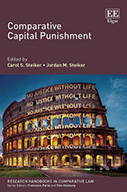Comparative Capital Punishment

Editors: Carol S. Steiker and Jordan M. Steiker
Publisher: Cheltenham, UK: Edward Elgar Publishing, 2019. 426p.
Reviewer: Philip Reichel | February 2021
This book is a welcome addition to the publisher’s Research Handbooks in Comparative Law series (https://www.e-elgar.com/shop/usd/book-series/law-academic/research-handbooks-in-comparative-law-series.html). The book’s editors are law professors at prestigious U.S. law schools, and each has engaged in scholarly and practical work on capital punishment issues. The book explores the commonalities and differences among countries in the worldwide movement away from the use of capital punishment. It does this with chapters that consider both general (e.g., attitudes toward the death penalty) and specific (e.g., methods of execution) topics dealing with capital punishment law and administration.
More than twenty authors from several countries and a variety of backgrounds (including academicians and directors of nonprofit organizations and action groups) have provided 19 chapters focused on specific death penalty issues. The chapters are divided into six parts providing a clear organization of topics.
Part 1, consisting only of the Introduction chapter written by Richard Dieter—the former Executive Director of the Death Penalty Information Center—serves as a good first chapter, but is disappointing for those hoping to have an overview of topics coming in the remaining parts and chapters. Instead, Dieter presents several intriguing ideas that set the stage for continued examples in other chapters, providing unique perspectives on familiar topics. For example, when analyzing worldwide trends in the use of the capital punishment, Dieter suggests that rather than discussing application of the death penalty by looking simply at the number of countries actively using it, we should count the number of people potentially impacted by its use—although a majority of countries have abolished the practice, two-thirds of the world’s population live in countries that retain the death penalty. Whereas it would have been interesting to have more comparison among countries (description of US activities predominate), there is an attempt to incorporate material from other countries.
The two chapters in Part II are on substantive law issues. Delphine Lourtau (Executive Director of the Cornell Center on the Death Penalty Worldwide) considers what public and private interests are at stake when states determine for which crimes the death penalty is an appropriate punishment. Further, how do the choices shed light on why some countries retain capital punishment when it has been abandoned by most countries? In Part II’s second chapter, Sandra Babcock (Faculty Director of the Cornell Center on the Death Penalty Worldwide) provides especially interesting coverage of attempts to distinguish between the moral culpability of certain categories of offenders and what category is entitled to protection from the death penalty’s application. Specifically, Babcock considers juvenile offenders, offenders with mental disorders (mental illness and intellectual disability), women, and elderly offenders. This chapter does a very good job of drawing examples from a wide variety of countries.
Part III includes three chapters on procedural law topics related to capital punishment. In Chapter 4, Bharat Malkani (Senior Lecturer at Cardiff University) explores the impact of extradition law on capital punishment by considering the legal framework governing extradition in potential death penalty cases, and reviewing the principles underlying that framework. The chapter concludes with attention to continuing concerns such as whether the existing legal framework for extradition cases should be extended to instances of mutual legal assistance. This important topic is too often ignored in general discussions on capital punishment and it is good to see it receive chapter-specific attention.
In Chapter 5, her second contribution to the book, Sandra Babcock notes that the right to legal representation is crucial for those persons facing the death penalty. Unfortunately, most persons accused of capital crimes are defended by poorly trained, under-funded, and inexperienced lawyers. The chapter includes a section on barriers to effective legal representation (e.g., a lack of lawyers, resources, and training in some countries, and persecution of lawyers in countries where the death penalty is used as a political tool), and another on the right to legal representation under international and domestic law. In that latter section, Babcock provides an interesting review of the role played by national bar associations—more so than courts—in setting minimum standards for capital defense counsel.
For Chapter 6, the third chapter in Part III on procedural law, Daniel Pascoe (law professor at the City University of Hong Kong) considers executive clemency in capital cases—another topic that deserves but seldom receives in-depth attention in any general reference book on capital punishment. The chapter reviews capital clemency powers globally with examples of variation among 58 retentionist nations, then proposes some plausible explanations (e.g., the political status of the final decision-maker) for differences in clemency frequency among countries still using the death penalty.
Part IV, on administration, has four chapters covering the topics of mandatory death penalty sentences (Chapter 7), methods of execution (Chapter 8), discrimination (Chapter 9), and innocence (Chapter 10). Parvais Jabbar (Co-Executive Director of The Death Penalty Project) provides an informative review of how and why there has been a global momentum away from mandatory death sentences in the last few decades. Austin Sarat (professor at Amherst College and author of many books on the death penalty) and Keshav Pant (Amherst College graduate) provide a very interesting comparison of execution methods in China, France, Germany, and Japan. In her chapter on discrimination, Carolyn Hoyle (professor at the University of Oxford and prominent researcher on the death penalty worldwide) focuses on under-researched countries in the Gulf and Asia, and explains why discrimination and arbitrariness in administration of the death penalty is best understood with attention to disadvantage as it links with ethnicity, religion, and citizenship. Brandon Garrett’s (law professor at Duke University) chapter concludes Part IV with a look at death row exonerations in China, India, Japan, Nigeria, Taiwan, and the United States — then considers causes of those wrongful convictions and subsequent reforms.
The four chapters in Part V all link broadly to institutions. William Schabas (professor at Middlesex University and at Leiden University as well as having drafted reports on the death penalty for the United Nations), explains in Chapter 11 why the claim by some countries that the death penalty is not prohibited by international law is incorrect. In doing so, he expresses concern that international law’s role in supporting a global abolition of the death penalty is under threat. In Chapter 12, Sangmin Bae (professor at Northeastern Illinois University) reviews the emergence, development, and institutionalization of the United Nations norm prohibiting the death penalty. Evi Girling (senior lecturer at Keele University) uses Chapter 13 to show the role of regional institutions such as the European Union and the Organization of American States, in death penalty regulation and abolition. With Chapter 14’s conclusion of Part V, Saul Lehrfreund (Co-Executive Director of The Death Penalty Project) explains the role of the United Kingdom’s Judicial Committee of the Privy Council (the court of final appeal for the UK overseas territories and Crown dependencies) in lessening the severity of the death penalty in some of the former British colonies.
The future of the death penalty is addressed in six chapters of Part VI. The common theme of these chapters is abolition. Mai Sato (Australia National University) starts broadly in Chapter 15 with a review of public attitude changes toward the death penalty in Ghana, India, Japan, Malawi, Malaysia, the United Kingdom, and the United States. She considers the factors influencing the change, such as miscarriages of justice and the victims’ movement, and concludes that the path to abolition is not uniform. In Chapter 16, Michelle Miao (law professor at the Chinese University of Hong Kong) analyzes the international campaign against capital punishment as an example of international law’s influence on domestic criminal justice and human right practices with special attention to the role of acculturation.
The remaining chapters of Part VI consider global abolition as a goal—even as utopia–from Chapter 17’s perspective by Jon Yorke (Director of the Centre for Human Rights at Birmingham City University) and Amna Nazir (lecturer at Birmingham City University). Yorke and Nazir use, in part, the interesting perspective of the death penalty in fictional dystopia as foretelling a retentionist dystopia where countries continuing to use the death penalty find themselves to be the new social outcasts of international human rights law. Another intriguing aspect of this chapter is detailed coverage of how and why the death penalty is incompatible with Islamic law, and a violation of international human rights.
In Chapter 18, Andrew Novak (term professor at George Mason University) suggests that global abolition of the death penalty would not only be a success of postwar international human rights activity but may also be considered a victory for comparative law. Novak sees three potential legacies for comparative law after abolition: the empirical (there are few topics as well- and as deeply-researched), the jurisprudential (much of the death penalty jurisprudence is based on human dignity so it will continue to be relevant after abolition), and the strategic (the incremental litigation strategy has proved useful in challenging virtually all aspects of the death penalty).
In the final chapter, the book’s editors provide a helpful analysis of commonalities among abolitionist countries and challenges to abolition existing in many retentionist nations. Carol Steiker (Co-Director of the Criminal Justice Policy Program at Harvard Law School) and Jordan Steiker (Director of the Capital Punishment Center at the University of Texas School of Law) are careful to note that every abolitionist country arrived at abolition through its own journey, but they also find some commonalities in the stories. While providing country examples, they note one contributor as being that abolition is often preceded by extended periods of reform, restriction, and restraint in the use of capital punishment. Among other contributors to abolition, they identify an association between abolition and democratic institutions, and regional pressure, persuasion, acculturation, and contagion as being examples of common features across abolitionist countries. Prominent challenges to global abolition are said to include the influence of Islam, high levels of racial division and conflict, and high levels of violent crime. Although there are several points raised in this chapter that appeared in earlier chapters of the book, the overlaps are not mentioned. This final chapter is not intended as a summary (the occasional footnote directing readers to other chapters would have been helpful) but does provide a conclusion of sorts in a final section titled “Conundrums” wherein the authors review problems when trying to predict the fate of the death penalty.
The book includes an extensive subject index that allows the reader to find particular countries and specific terms appearing throughout the book. When combined with the organization by parts and the very descriptive chapter titles, it is possible to find rather quickly a topic of interest to the researcher or casual reader. This book also lends itself to teachers looking to include comparative material on the death penalty in course lectures. One can imagine, for example, a lecture on indigent defense counsel in the U.S. benefiting from examples in other countries that show similarities and differences regarding barriers to effective legal representation. The book should be available in university libraries and on the bookshelf of scholars with specific interest in any aspect of the death penalty.
Reviewer’s current position: Adjunct Professor, University of New Hampshire, Franklin Pierce School of Law


